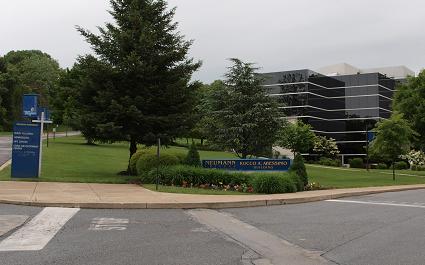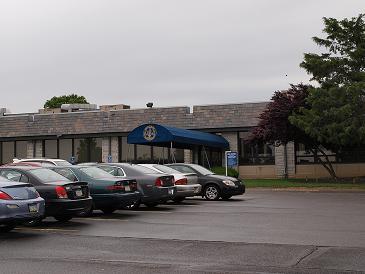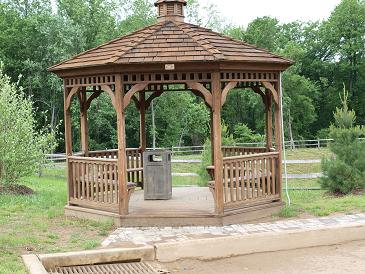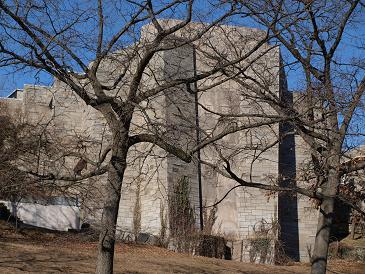
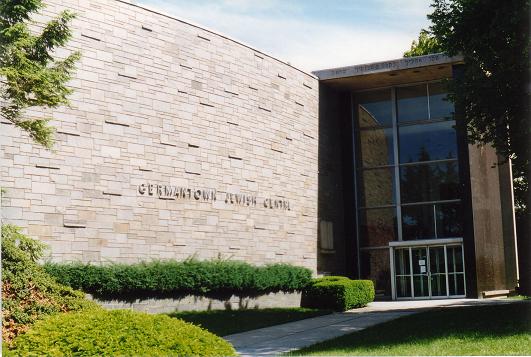
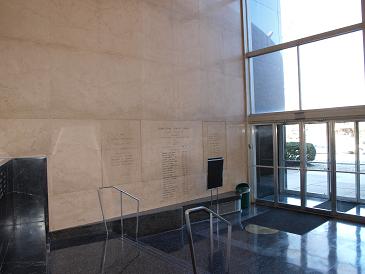
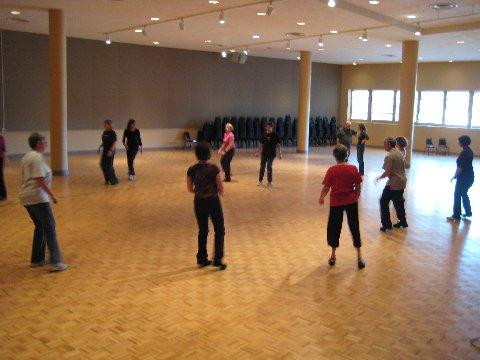
There is a page of GPS designations for most Israeli dance locations locally and you can access that page by clicking here
Although most dancers are interested in the dancing, the venues that we dance in are kind of interesting also as this script tries to detail. You can click any underlined header to see a map to the location.As you make your way up Lincoln Drive past McCallum Street (this is heading north), the (Germantown Jewish Centre) looms like an imposing castle. No doubt there was some attempt to represent Mount Zion or Mount Ararat in the design as you can see to the right by way of a shot from Lincoln drive.
The center (and notice the difference in spelling, here - from its inception the official name is the British oriented Centre) was built in 1947 and from its earliest days was a progressive Conservative synagogue committed to lifelong education, egalitarianism and maintaining its congregation in a diverse urban setting.
An organized Israeli dance session has been in existence since 1997 through the efforts of Tamar Magdovitz and many others. Since 2003, the group has been led by Grant Shulman.
Officially this is its mission statement:



This wonderful 100+ wooden year old building is a mecca for anyone in northern Delaware state, southern Delaware county who loves the arts. Speak about dedication. At anytime through the year the building is a continual host of concerts, dances of all type (and obviously an Israeli dance session is included in this) art and fair shows, plays and the disk coordinator's favorite - the Gilbert and Sullivan festival. The sign on the wall, photographed below, 'Ye are welcome here' is very apt.
The Gild hall, shown to the right at night in the moonlight, is on a tract of land that also has a swim club and open space to hold the Gild Fair every year on the Saturday of the Labor day holiday. We'll discuss the fair more in depth later.
Although he is hesitant to make this public, the disk coordinator first saw and was swayed by the Arden when he was involved with cajun and zydeco dancing. The Arden Gild was one of two locations in the Philadephia area at the time(the other being a combination bar/disco in Rozborough) where this type of Louisianna music and culture made inroads in the Phila area.
Even today, the Arden Gild continues to host Cajun and Zydeco music
concerts. So, if the name Buckwheat Zydeco means anything to you, you have
visited the Arden Gild because this performer is an annual draw.
As far as Israeli dancing is concerned, the Gild has hosted an Israeli dance
for the last 4 years. This January, January 6th, 2009, this schedule evolves
to the 1st and 4th Wednesdays of the Month. From a handful of dancers, it is
a pleasure to have danced with 18 other participants recently. And there is
a passion for this type of dancing as there is a passion for all the other
activities at the gild, the participants applaud when successful in dealing
with a new Israeli dance.
As mentioned before, every labor day the gild holds its Gild fair. This is a wonderful experience for anyone not subject to claustrophobia. The Gild grounds are packed with artist kiosks and a mass of festival goers. In fact, it is so crowded that you are required to bus in unless you live in the neighborhood and can walk in
At the same time that chaos reins outside, inside the building dance demonstrations and concerts go on non stop This year, for instance, several members of the Israeli dance group performed a set of dances for an hour while an Indonesian dance group, torches and all, stood at the ready to display their talents when the Israeli dancers finally stopped circling. And, even better, the gild picks up the cost of the fair as the admission to all of this is free.
Below, is the mission statement of the gild and some comments from the
Israeli dance leader, Sharon Kleban:
From the Ardenclub online: The utopian community of Arden, Delaware, is home to the Arden Club, Inc. which offers residents and friends the opportunity to act, sing, cook, dance, garden, read, swim, and to think deeply about economic philosophy.
From Sharon: The Arden Club is a membership club that is an umbrella for numerous special-interest clubs, called the Gilds. The Folk Dance Gild is one of these clubs and has been around for more than 50 years. Every Wednesday night plus 1-2 Sundays a month there is international, square, contra, Cajun, and of course Israeli dancing. Currently Israeli dancing is first and fourth Wednesdays each month, but the schedule varies according to Jewish and secular holidays and competing uses for the Gild Hall. Please check www.ardenclub.com and click on the Folk Dancing link for the most up-to-date schedule.
One of the most popular events of the Arden Gild is the annual Arden Fair held on Labor Day Saturday. This web site has covered the Fair for several years and the following links below can be used to access these scripts.
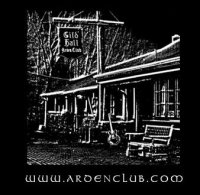

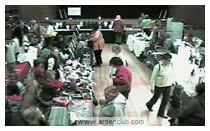
What can you say about dancing at a National Historic Landmark as you would be doing if you dance at either of the sessions (Sharon Polsky on Tuesday and Don Schillinger on Wednesday) held at Beth Shalom on the Old York Road corridor. The reason: only one synagogue has ever been designed by Frank Lloyd Wright and Beth Sholom was his last project. Similar to the Germantown Jewish Centre as you approach from Lincoln Drive, Beth Sholom towers over Old York Road as you approach the building. Theoretically and theologically, this is supposed to represent Mt Sinai. Practically, this may be the only building in the country to host two different and non related Israeli dance events.
To be fair, the Israeli dancing is done in one of the banquet halls and you do not get a fair view of the architectual mastery of the synagogue in general. It's only when in the chapel that you are given a glimpse into Wright's genius. The multilevel seating and the arch of the ceiling truely are magnificant as you can see at the right. If you go onto the Beth Sholom website, www.bethsholomcongregation.org, you can see that tours are available of the facility and, if you have some free time, you might want to partake of this and see another view of the synagogue beyond the scope of the latest Israeli dance.
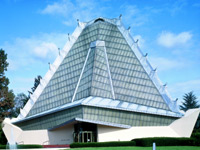

Temple Beth Sholom, at Cropwell and Kresson at the border of Cherry Hill and Voorhees (but distinctly residing in Cherry Hill) plays host to the Cherry Hill group on Tuesday nights. Use this link www.tbsonline.org to see their own write up of their history which is quite extensive. But the disk coordinator will use this space to discuss the building's interaction with the Cherry Hill dancers. First, though, we are told that this is not the first time this building has been used for dancing. Predecessors of this group have met at several synagogues and facilities in East Cherry Hill - the Katz JCC and the Beth El education center (soon to be the Beth El synagogue) come to mind - but someone has told the disk coordinator that for a short period this synagogue was also used in the late '90s for weekly Israeli dancing.
Whatever the case, the Cherry Hill group has been pleased with the welcome that this synagogue has provided. Besides ample areas to dance and an attempt to publicize this service for their own members, what can you say about John who is the night maintenance man at the facility. He has gone out of his way many times to increase the comfort level of the dancers including an unending eye to temperature control. He has complimented the group as far as dance ability is concerned and has even come up with nicknames for several of the regulars. Facilities are not just bricks and mortar, they consist also of people and John's altitude has made the jump to Temple Beth Sholom enjoyable for all concerned.

To discuss what was once called the Y's in the Philadelphia area and now known as the JCC's. you really have to go back and look at changes in society over the last 200 or so years. When most societies were primarily agriculture, the hard work gave everybody a type of athleticism and this hard work kept many from the pursuit of more nefarious pastimes. With a move to the cities that many a young man experienced as society changed to a more industrial flavor, many worried about how to keep these young men's minds and especially bodies active dealing with higher pursuits. It is said that in Scotland in 1797 or so, the first of what would become known as the YMCA was founded. It was an attempt to guide these young men into more Christian (if you will) pursuits. By 1844, this concept spreads and the first YMCA in London is founded on June 6 of that year. Our knowledge of this date in history has been obscured by the events on the same date a hundred years in the future, but at the time this was the precursor of the movement of these Y's into this country and the first American YMCA was founded in Boston in 1851.
To serve Jewish men (and then women) a similar type of institution (called the YMHA) was organized in Baltimore a few years later. It is said that with the help of well-to-do German Jews, the first YMHA in Philadelphia was opened in 1875
Philadelphia would have been very different at that time from what we see now geographically. The county of Philadelphia contained many townships, one of which was the township of Philadelphia. The township extended river to river and from Spring Garden (named after the spring whose mouth is where the present day Art Museum is situated) to Keswick street which was generally known (and known today) as South street. Where in the township this Y was placed, we cannot tell you. What we can say is that in a year vast changes to the city would result. The consolidation of 1854 merged all the townships to the point where the city and the county were the same. This opened up the Passyunk and Moyamensing townships (below South street) for development and as a result large migrations from Europe settled in what is now known as South Philadelphia including a considerable Jewish presence. It is not surprising to learn that in 1924 what is now known as the Gershman Y was built a block above the Broad and Keswick (Broad and South) location for easy accessibility for South Philadephia residents.
The previous building, wherever it was, would be of interest to those facinated with the use of that building in basketball of all things. One of the most famous basketball teams of all times, officially designated as the South Philadelphia Hebrew Association but shortened to SPHAS as an abbreviation was part of the American Basketball League, a precursor to the NBA. It is said that originally the team had sponsorship at the Phila. YMHA before the organization they were named after took control in 1921. Games would have been played at the location of the Y before it's move to the Gershman building and it's possible that the building process of the Gershman, completed in 1924, in some way affected the Sphas relationship with their former mentor and aegis and may have forced the relocation. You can see more on this by using this link to go to a website that deals with the history of the SPHAs.
What can be indicated, from the inception of the Gershman Y building, was the importance of this facility in center city Philadelphia for the Jewish population at that time. This deals with both image and substance. It becomes a center for Jewish athletes and this is where they would train and get together. You can see this at the museum that has been established in the first floor of this facility which is a hall of fame for the Philadelphia region's Jewish athletes many of whom would spent a considerable amount of time at this Y. We should however add that a considerable number of cultural events occurred at this location and this continues and is a great importance today as the athletic facilities at this site no longer exist. For example, and it is appropriate to add this here, that the highly acclaimed Jewish Film festival uses the gershman facilities each year as it is an eagerly awaited, ever increasing in popularity, annual cultural event at this center at the present time.
This author can speak personally of the Gershman as he was an attendee of a summer day camp there. This was 1960 and he would ride the new Budd El trains to the building where it was a day of swimming, games and arts and craft pursuits. He is sure that he is not the only Philadelphia resident who enjoyed this experience.
At sometime post 1960, the old names for the Broad and Pine facility, The Young Men's Hebrew Association, was replaced officially by the designation of the Gershman Y. No doubt this change caused some regret especially for those who cherished the SPHAS infuence on basketball and the role that the YMHA played in this, but by this time the NBA was well established and didn't need remembrances to this link to be successful.
Sometime in the late 60's a decision was made to expand the idea of the Y into the other areas of Philadelphia with the first expansion occuring in the Haverford and City ave area just outside the north western part of the city. A large property at one of the corners of this intersection, which we think was originally a convent and school of the Catholic Church, became available and was bought with the purpose of establishing a center based on duplicating the activities of the Gershman Y. Eventually new facilities were constructed housing an athletic center with additional space for different types of athletic type classes like Yoga, spinning, etc. Eventually, some years out, an Israeli dance class would be established using one of these rooms which was never satisfactory (per the dancers' opinions) based on the limited space. Once this center, designated first as the Western Y and then the Kaiserman branch, was secured, attention now was paid to the great Northeast which at the time had a large and ever increasing Jewish population.
To that end, a purchase was made of undeveloped land between the Reading tracks and Jameson Road at Red Lion Rd. This tract would eventually contain senior citizen housing in the form of the Tabas and Rieder houses (And the Rieder house was the scene of a Cherry Hill field trip in Oct'10) and a new Y facility to be designated as the Klein Branch. Like all facilities of this nature, provision was made for athletic pursuits such as track and weights, pool facilities and meeting rooms. But, given the newness and modernity of this facility, more space was alloted for these community type rooms, one of which would eventually host Israeli dancing each Sunday.
Sometime in the 1980's (it seems anywhere between 1984 through 1986) Israeli dancing secures a foothold at the Gershman Y as it leaves the Univ. Of Penna. Hillel across from the International house at the University of Penna. Using the 3rd floor ballroom (the 3rd floor at the Gershman Y was made for dancing with this ballroom anchoring a floor that included a large ballet studio which doubled as a ballroom dance facility) many of the regular present attendees of Israeli dance locally got their initial introduction to this type of activity, what we call Israeli dancing. It should be noted that the Y did not directly administer this class as it did others. It, in essence, provided space. This website's repository script details the underlying administration of Israeli dancing while at the Gershman Y. What's known as the committee, several dancers who would double (if not triple) as teachers and administrators, ran these sessions independent of the Y's administration on Wednesday night through the middle 90's. Committee members included Steve Schwartz, Sharon Polsky, Ellen Weber and Rob Malerman.
Besides this class, many other classes in dance including ballroom were regularly run out of the 3rd floor. It was very impressive to visit the Gershman Y at the time with these activities being added to the normal hustle and bustle of athletic activities occurring several floors below and many people took advantage of this by spending an evening working in the gym, showering and heading upstairs for a dance class. At first, except for the Israeli dance part of this, you could have similarly described the activities at the two other Y's during this period through 1987. However, in October 1987, Israeli dancing officially expands to the Klein branch when Rob Malerman initiates Cafe Israel (as described below) at that location on Sunday nights.
In 1990, across the country, the YMHA (and YWHA) designations were changed to the designation JCC for Jewish Community Center. In the Philadelphia area, the Israeli dancing now expands out to Kaiserman and to the Klein branch as indicated above in the aforementioned Cafe Israel. This Sunday night event, administered by Rob Malerman, was a concept where Americans and Israelis would meet for both conversation, dancing and coffee. A larger room used for conferences became the home of this session at Klein and it is in this location on Sunday nights that Israeli dancing continues today. At Kaiserman, Israeli dancing was done during the week and several sites were used including some rooms used for Yoga and the like in the athletic center and a gym in a school situated in a building that was also on the site. This was the highpoint for both Israeli dancing at the Y's in Philadelphia and for the Y's in general in terms of activities.
By the late 1990's it was clear that Gershman could not survive in its present state given that its base of support and population no longer lived in Center City Philadelphia, so its athletic facitities were taken out and the sound of dribbling basketballs no longer was heard. Additionally, the sound of dancing feet as far as Israeli dancing was concerned was stilled as parking prices effectively doubled to tripled the cost of the session and this activity was abandoned in the late 90's and moved to other facilities in the suburbs where they remain today. By 2001 the building had been sold to the College of the Arts and an arrangement was created where the Gershman would use the lower 2 floors and the college the upper 2 floors with security and maintenance at the college's cost. The ballroom on the third floor, not to mention the ballet and dance studios, are now under the purview of the college.
By 2007, the fabric of regional control of the JCCs was fading and it was decided that each center was to go its own way both program wise and financially. By 2010 this separation was complete and you can see this on their web sites where virtually no links between the centers survives.
Klein is the only one of the centers to administer a facility off of its campus, the Stiffel senior citizens center at 6th and Porter in South Philadelphia. The author has personal knowledge that this facility, Stiffel, has a large membership and meets the needs of residents in that area who are mostly older. No athletic facilities are at Stiffel but a wide ranging cultural agenda is followed.
Israeli dancing, as we know it, no longer is done at the Kaiserman center. At Gershman, a yearly revival is staged by Hannah Chervitz, Mitch Ginsburg and Rob Markowitz in late January on the one-time gym floor where basketball was a daily feature. It is only at the Klein JCC that a regular class is held on Sunday nights. As stated, originally this class was run by Rob Malerman. In 2000, this session was closed for a short hiatus and then reconstituted by Rob Markowitz who ran it until Nov 15, 2009 when an administrative transfer occurred to Don Schillinger who now administers this class with Rob and he both taking turns as DJ and instructor. In October, 2010, much needed work was done on the dance floor which was replaced with new concrete.
Several members of the Cherry Hill session paid a visit to the Klein session, Sunday night, Oct 24, 2010. We were there to document their visit and to photograph the inside of the Klein facility.
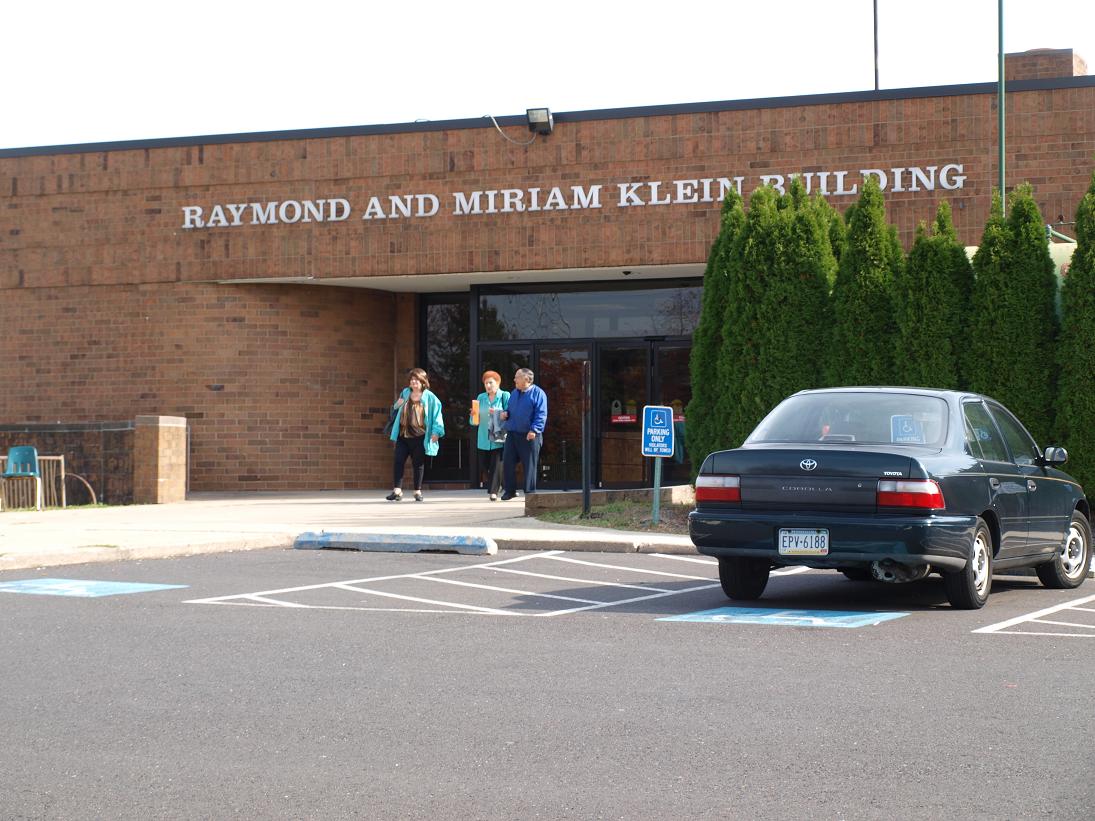
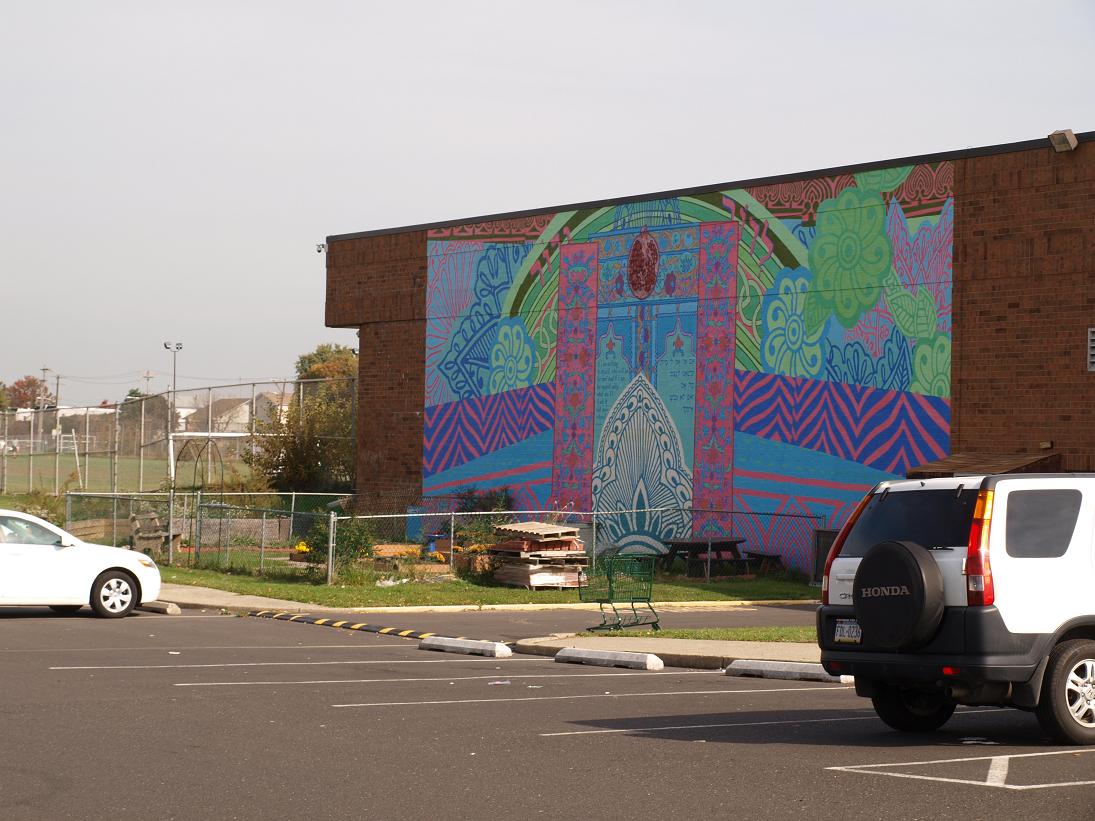
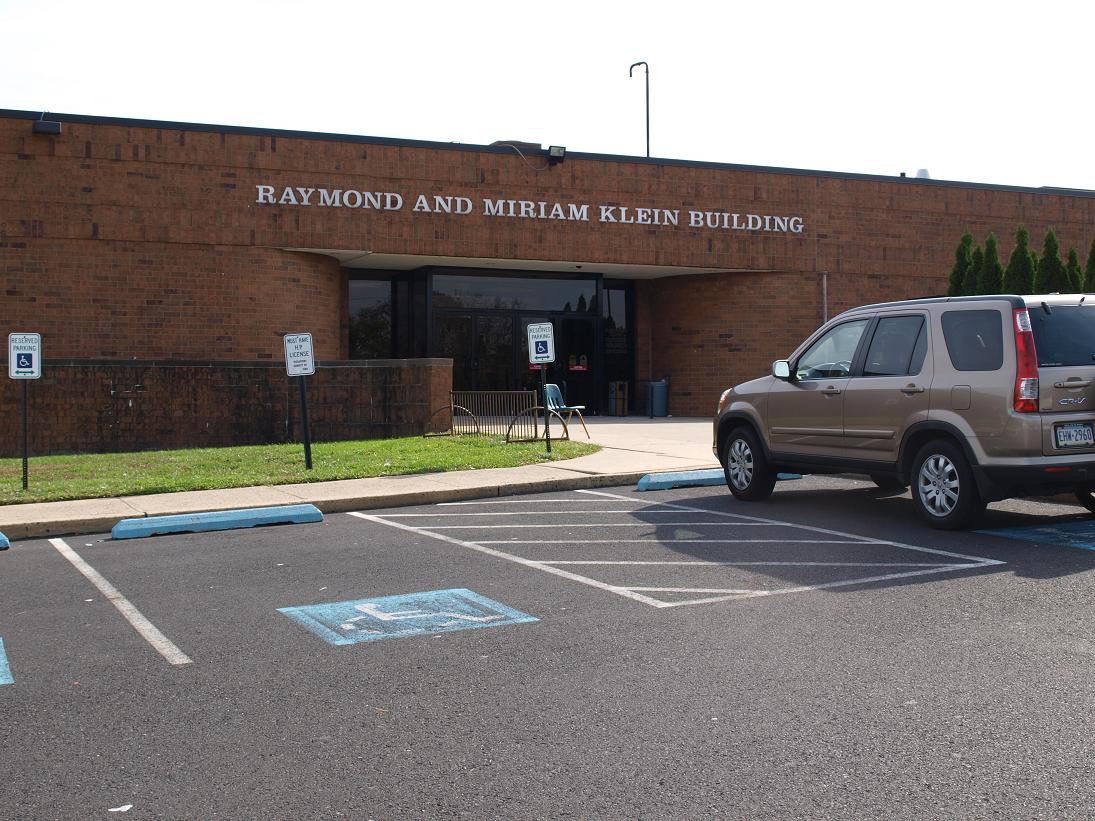
One could say about our next location that it is the nexus of the disk coordinator's interest in Israeli dance coupled with his interest in Ian Fleming. As you may be aware, Hora Aviv generally holds its event in the Southeast Pennsylvania area and in 2008 this event was held at a college in Lower Gwynedd off of Route 202 and 309, Gwynedd Mercy College.
You are also aware that anyone having an interest in Ian Fleming - and the disk coordinator pleads guilty to this type of mania - would also have an interest in James Bond. No, No, No, not that James Bond, the fictional character and hero of multiple movies. We direct your attention to James Bond, the ornithologist, who worked at Philadelphia's Academy of Natural Sciences and whose book, Birds of the West Indies, Fleming allegedly used in determining a name for his character. This is described in the kicker to the G11 disk which you can link to by clicking here.
Gwynedd Mercy College resides on part of the Bond Estate which that family designated as Willowbrook. After his Wife died and he and his family were about to move to England, James Bond's father, Francis Bond, sold the estate to a Roland Taylor in 1914 who subsequently sold the property to the Sisters Of Mercy in 1946 so that this order could establish 3 schools of education, an elementary school, a prep school and a school of higher learning which we know today as Gwynedd Mercy College. Although this is not a primer on educational history in this area, this was not uncommon in Philadelphia or its suburbs after World War II. Schools such as Cabrini, Holy Family, Manor and Neumann college (now Neumann University) were also created in similar manners. Someone has told the disk coordinator that this was the result of urbanization of the Philadelphia suburbs and the resultant increase of real estate taxes on these manor estates forced many families to make similar decisions to sell these properties as did the Taylors.
The disk coordinator recently visited this campus which has at its center the old estate home of the Bond family which you can see at the right. It is apparent that the school has preserved much of the interior of this home, which is more of what we would consider an English style manor. While school offices inhabit each room, one does get the effect of this older form of architecture. Next to the house is a pavilion which the disk coordinator has been told dates back to 1907 when the house was occupied by the Bonds and provides an almost bucolic atmosphere where one can sit or stand and ponder the events of the day. Would it seem silly to relate to you that the disk coordinator did exactly that and looked at the fauna and thought about a young James Bond, growing up in this house, perhaps standing on the same spot while looking at the birds that may have been nesting on the estate. Perhaps this is where his interest in ornithology began. To be fair, research indicates that his father, Francis, was a famous ornithologist in his own right and this may have influenced the son. In any case, wouldn't James Bond be surprised, probably embarrassed, that the grandson of Russian, German and Polish immigrants would be at the same place perhaps a century later brought here by the fame of his name and not for the fact that he became one of the pre-eminent ornithologists of the world.
The rest of the campus is obviously of newer buildings and construction which would not have existed at the time that the Taylors (or the Bonds) were in residency, yet, everything seems to blend in very well. The disk coordinator also took the opportunity to visit the gym that was used for the Hora Aviv event, Griffin Auditorium, a short walk down the path from the manor house. Prior commitments kept him from last year's Hora Aviv weekend so it was interesting to see, a year later, where the nights of dancing occurred. This Gym is, in itself, quite interesting with a track circling the basketball court (the track would disappear when the retractable seating to the right would be deployed) with plenty of natural light coming in from the higher level windows as you can see in the picture to the right, giving the effect, to some degree, of an atrium. It would have been interesting to experience several evenings of dancing under the stars last year if the disk coordinator had been in attendance.
Dancers who were in the Philadelphia area remember the International dance sessions at the Art Museum during the '70's (and possibly earlier). This wopuld be the sessions on Tuesday night during the spring and summers. Colder weather would see these sessions being held in one of Boathouse locations on the then East River drive - now known as Kelly Drive.
Running dance sessions at the Art Museum at that time was a lot simpler. This was Pre 9/11 days. Licensing by the City was more sporadic and insurance by the organizers pertaining to security matters was probably not needed. We are not even sure if the present payment policy (only through voluntary contributions) was in effect at that point. Today it's a very different ballgame. Insurance can be expensive and the city itself over the years has been running more and more events at this venue during summer months cutting down the availability of the site during these periods by session organizers.
Even without this interruption by city events during the week leading up to the Independence and Labor day weekends, the site provides several other problems. One of the problems is the concrete flooring on the East Terrace of the Art Museum (This is acccessible by the steps shown in the 1976 movie Rocky) leaves a lot to be desired and can be hazardous in terms of fals and sprains to dancers. Another problem that can be painful is the lack of bathrooms. For the session leader, there is the problem of electrical supply and would-be session leaders are advised to bring a long length of extension cord to use with the one electrical socket outlet available. Nevertheless, for the last few years, Don has run his Thursday night sessions during the late Spring through the early Fall at this locale.
The pictures accompanying this discussion were taken on an early September'14 afternoon and evening at the site. Many dancers who frequent Don's sessions during the fall and spring will not attend the Art Musuem site. Other dancers (generally novices) have their first, possibly only, experience with Israeli dancing in this center city location. At other times, dancers from Wilmington and Cherry Hill will make it to the Art Museum session whereas the additional mileage into the suburbs of Philadelphia to attend Adath Israel (where Don holds his Thursday session when not at the Art Museum) is too much of a journey. So, it is an irregular group of dancers that meet on these Thursdays
Having mentioned the pitfalls, we would be remiss if we did not include the positives. There is something exhilerating about dancing under the stars and there is no better location than the East Terrace of the Art Museum. There is a grand view of center city and the horizon as one dances the night away. Generally there is a cool breeze that allows dancers to forget about air conditioning for the evening. The terrace contains a fountain which just adds to the effect.
Don deserves a lot of credit for maintaining a dance session in this part of the city. And he does it while being supported (although it probably does not make up his costs) by small voluntary contributions from some of the dancers. In addition, it is with increased difficulty that he deploys his equipment on the terrace for each of the sessions as he needs increased electrical and volume support. So, we leave this discussion of the Art Museum by complimenting Don and several selected dancers on their involvement here despite some difficult conditions.
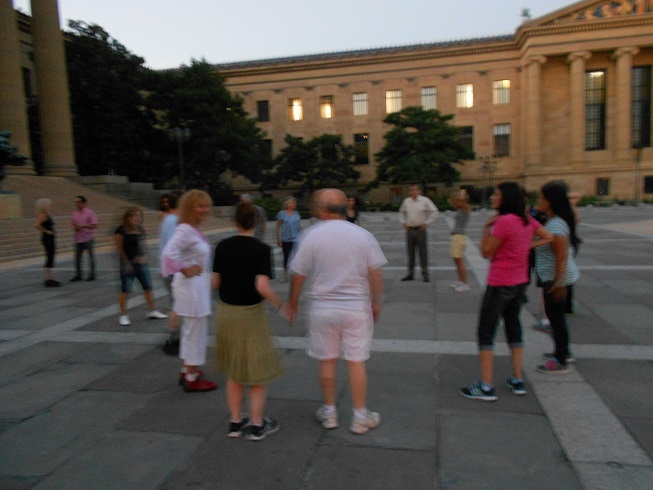
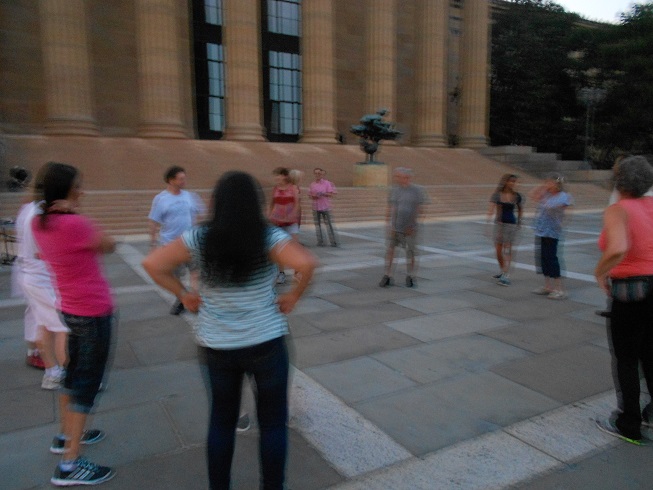
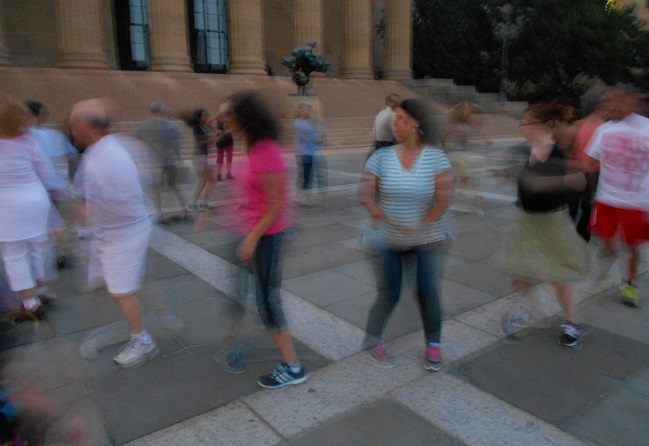
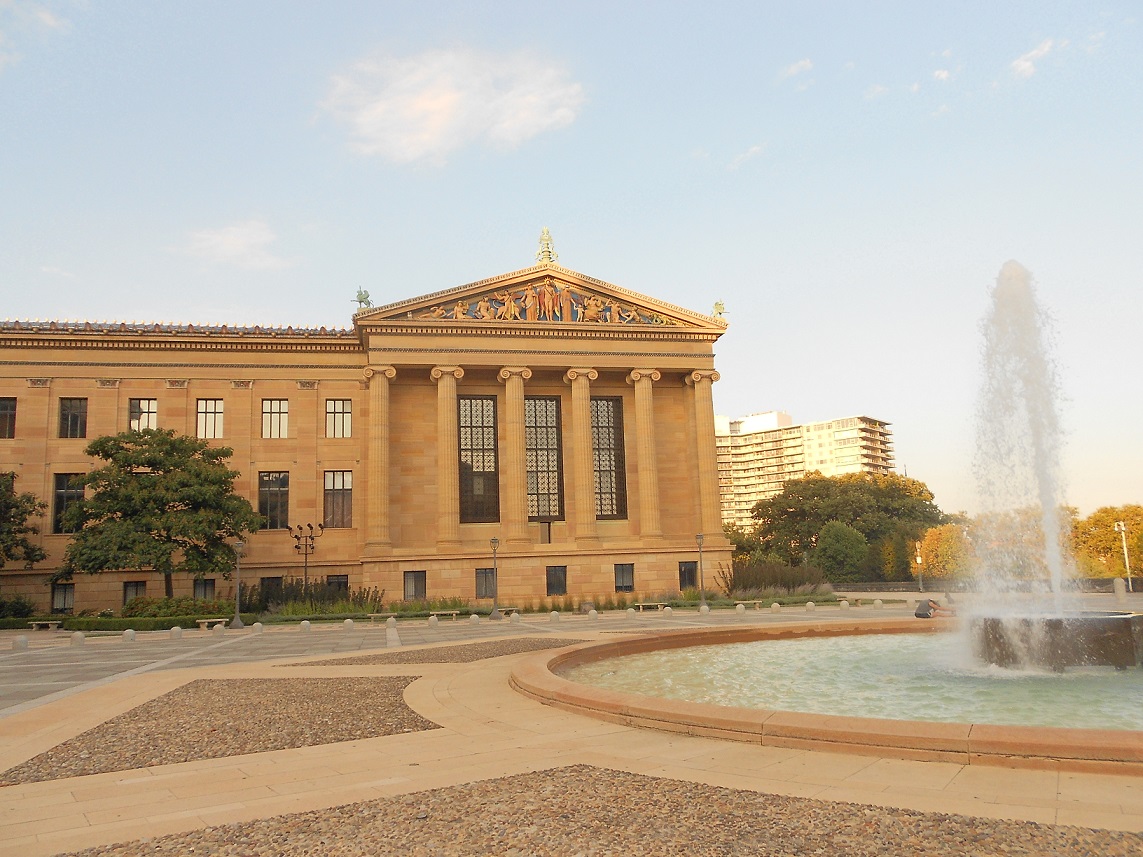
In general, if you ask Hora Aviv participants which location was the best as far as accomodations were concerned, you will get Neumann College as the answer. Neumann hosted Hora Aviv for 4 years from 2003 through 2006. For those who attended, the disk coordinator would like to indicate to you that there have been changes to the school since 2006. First, you should be aware that with the addition of graduate courses, we are now talking about Neumann University. This continues a trend of growth in academic programming for this school that began in 1964 when the school was established.
And, in addition, next door to the dorms that were used to house the Hora Aviv dancers, a new sports complex is being developed. You may remember walking by tennis courts to get to the auditorium that we danced at. These tennis courts have been relocated adjacent to this new sports complex. The second picture to the right is a picture of the Bruder Center for student life which housed the gymnasium where we danced. This Gymnasium is the home of the Neumann Knights basketball teams which we assume will relocate (as the tennis courts did) to this new center. The picture top right is the main administrative office building on Neumann Drive.
You can find a history of the school on their web site, www.neumann.edu but in brief, the school started as a nursing school governed by the Sisters Of St Francis. Since there was a convent house in Glen Riddle (The post office has now designated this area as Aston), the school was established on land just to the west of this convent house, for which Convent Road is named. For the historians among you, the Riddle name should be familiar. This pertains to a prominent Philadelphia family which today is best known for its activities in horse breeding and its ownership of Man'O'War and War Admiral.
By 1980, the school had grown both physically and educationally that a new name was designated, Neumann college. This is named after John Bishop Neumann who was canonized in 1977 and whose legacy involves many things involving the Philadelphia Arch Diocese including the establishment of Catholic education in the United States. The campus provides the rural setting that it was at the time of its creation, but suburbanization has crept around it over the intervening years to the extent that the new athletic center required the purchase and leveling of some privately owned homes. But, the school maintains its rustic nature by maintaining a set of gazebos, one of which you may remember in front of the dorms when Hora Aviv was in session there. To the bottom right is a photograph of one of the gazebos on campus providing students a respite from their studies and at one time providing the dancers of Hora Aviv a respite from their aches and pains.
